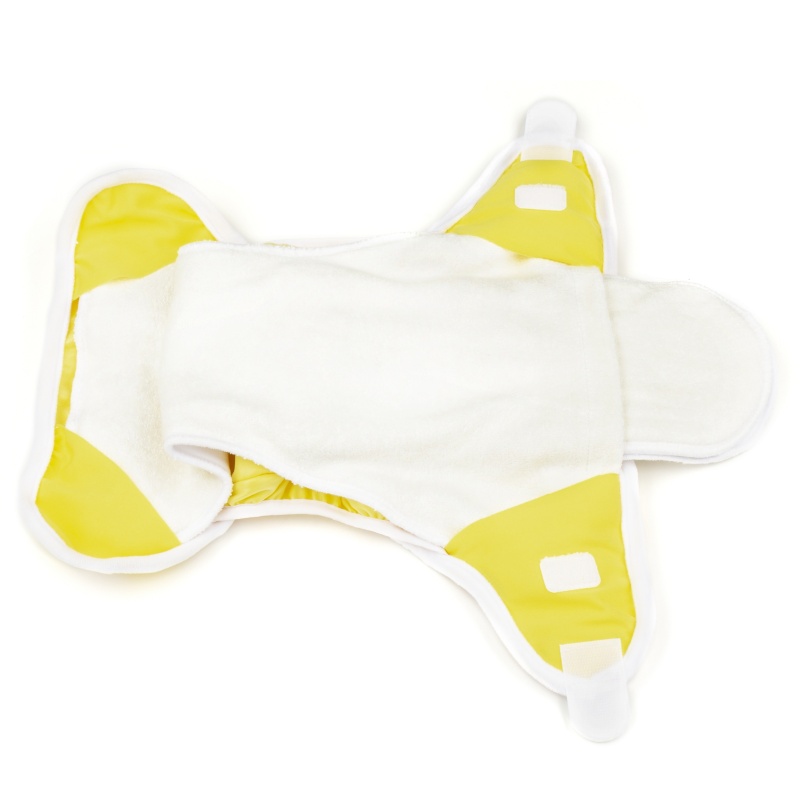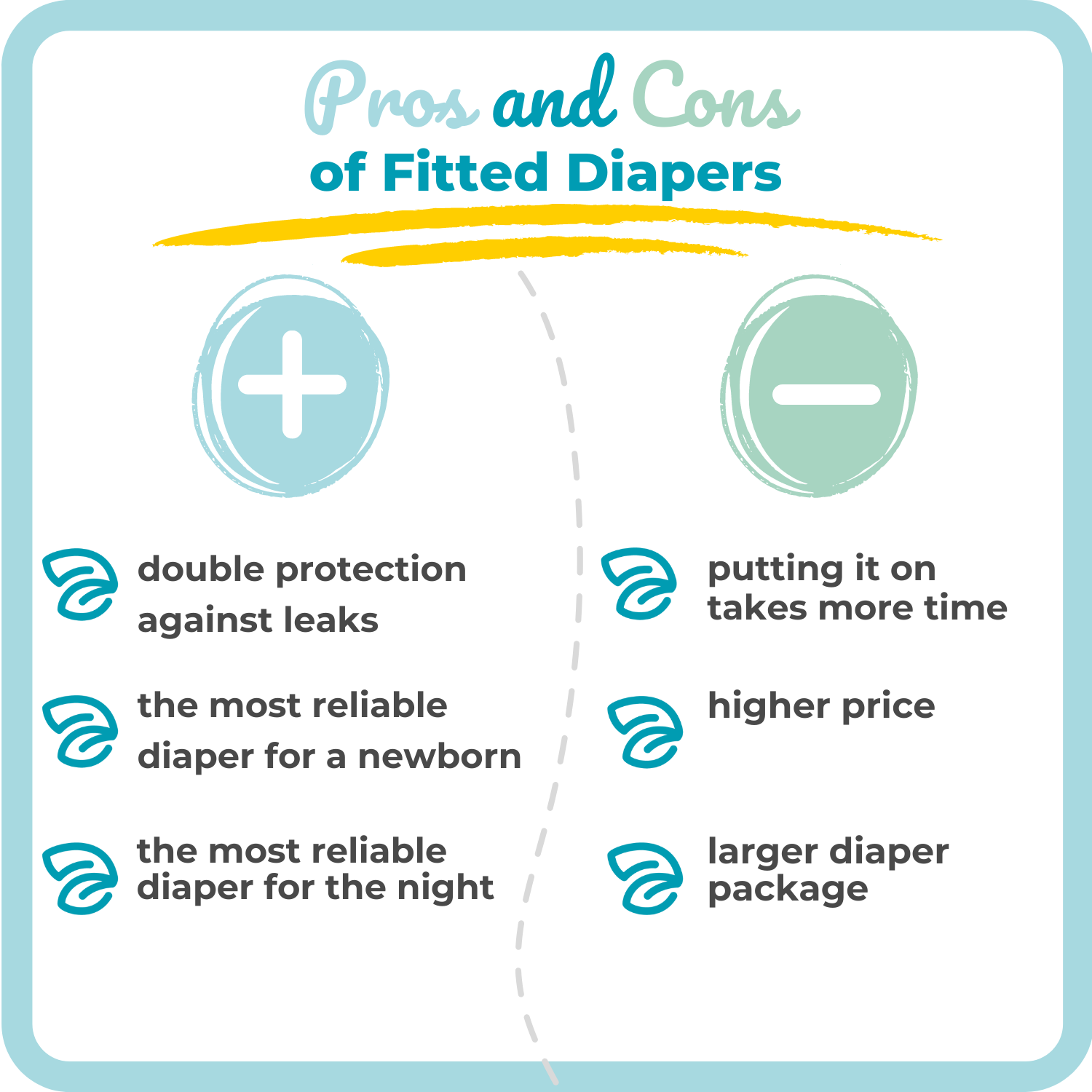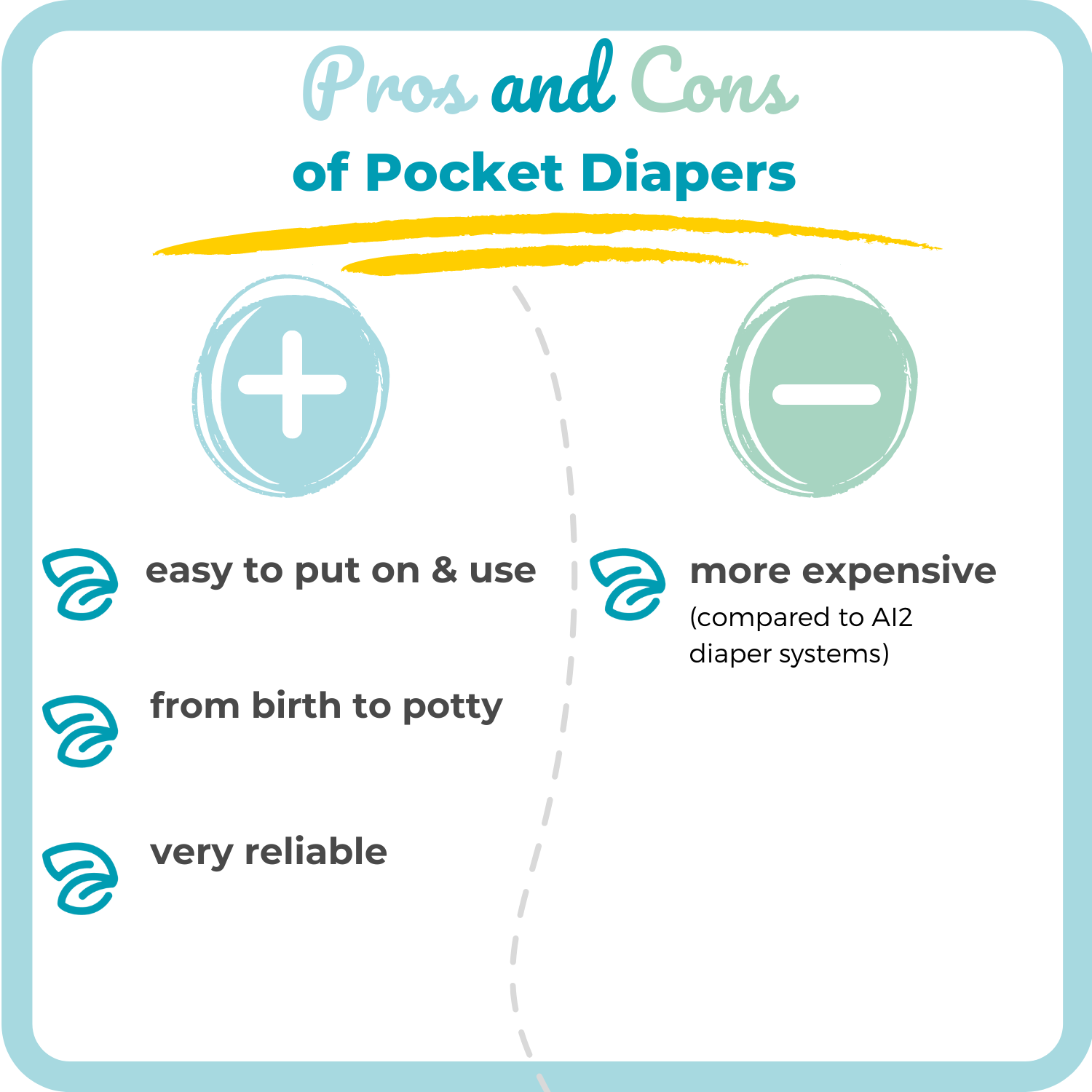What is what in the world of cloth diapers? What are the differences between cloth diapers types? Learn about the basic cloth diapers terminology with us! You’ll find out all the pros and cons of cloth diaper systems.
Types of cloth diapers
The basic rule of cloth diapers is easy. A functional cloth diaper needs two layers:
- an absorbing layer and
- a waterproof layer.
Based on this rule, all cloth diaper systems fall into one of these two categories:
- Cloth diapers with the two layers being separate (All-in-2 diapers = AI2)
- Cloth diapers with these two layers in one (All-in-One diapers = AIO)
Then there are cloth diapers that combine the best of these two diaper systems:
- Pocket Diapers that are basically AIO diapers but their layers can be separated.
- Fitted Diapers that are a very sophisticated absorbing layer of advanced AI2 diaper systems.
AI2: Waterproof and absorbing layers are separate
You may also encounter the term “SIO—Snap-in-One" for AI2 diaper systems. That’s when the absorbing inserts come with a snap by which they’re attached to your Diaper Cover.
AI2 diaper systems always have the waterproof layer represented by Diaper Covers; into which you put absorbing inserts. There are many types of absorbing inserts—most often, you’ll come across with:
- Absorbing Inserts made of highly absorbing fabrics. They usually come in various sizes within one diaper system and are designed to fit into Diaper Covers in all stages of your baby’s growth (so that you could use them for a newborn as well as for a toddler). They can be combined with each other.
- Bamboolik offers Shaped Absorbing Insert with Pocket (made of bamboo terry + Stay Dry or made of organic cotton) which is a sufficient absorbing insert for a newborn or a smaller baby. As your baby grows, you can add a Short Insert (again, in bamboo terry + Stay Dry or in organic cotton version) in the pocket of the Shaped Insert. Later on, Long Insert (bamboo terry + Stay Dry or organic cotton) will make the diaper sufficiently absorbing even for a toddler.
- Muslin Squares. A very cheap and very traditional diaper change. There’s an article on our blog with tips on How to save hundreds or EUR on diapers with Muslin Squares. In our book, this is a great budget-friendly option for babies up to approx. six months of age. For older babies, it can be a bit lacking in absorbing capacity—we’d recommend adding a few Short Inserts to your diaper stash to boost it (choose organic cotton Short Inserts as they’re more absorbing).
- Universal prefolds. These are still very budget-friendly and very universal plus they’re more absorbing than Muslin Squares.
The best feature of AI2 diaper systems is that you don’t have to wash the entire diaper change after each use. Only the absorbing inserts need to be washed, Diaper Covers just need to be aired for a while, and you can use them again. You need to wash your Diaper Covers only when they’re soiled or when you’ve been using them for a week or so (use your nose to guide you when they’re washing-machine-due :-)). This means AI2 diaper systems are cheaper—you only need about six Diaper Covers to get you literally from birth to potty.
AI2 diaper systems are very universal. If you combine your absorbing inserts wisely, 20 of them will be sufficient for the entire diaper period.
Variability is another advantage of AI2 diapers systems! The absorbing inserts come in many sizes and shapes so you can always adjust your diaper change according to what you need at the moment. A diaper change for a newborn, for a walking toddler, or a diaper change for the night—everything is achievable. It’s like playing with Lego cubes—choose the one that fits the best.
However, this advantage makes using an AI2 diaper system slightly less intuitive. It’s no rocket science :-D but if somebody else comes to babysit, they will need at least a short explanation “this belongs here and this is how you put in on”.
In case you use Muslin Squares as your absorbing inserts, folding a well-fitting newborn fold might take you a few tries. Actually, changing a newborn’s diaper with an AI2 diaper system can sometimes be a challenge—liquid newborn stool likes to stick to the hems of Diaper Covers which means you might need to wash them more often. (The just mentioned newborn fold is a great prevention against the so-called “newborn explosion”, by the way.)
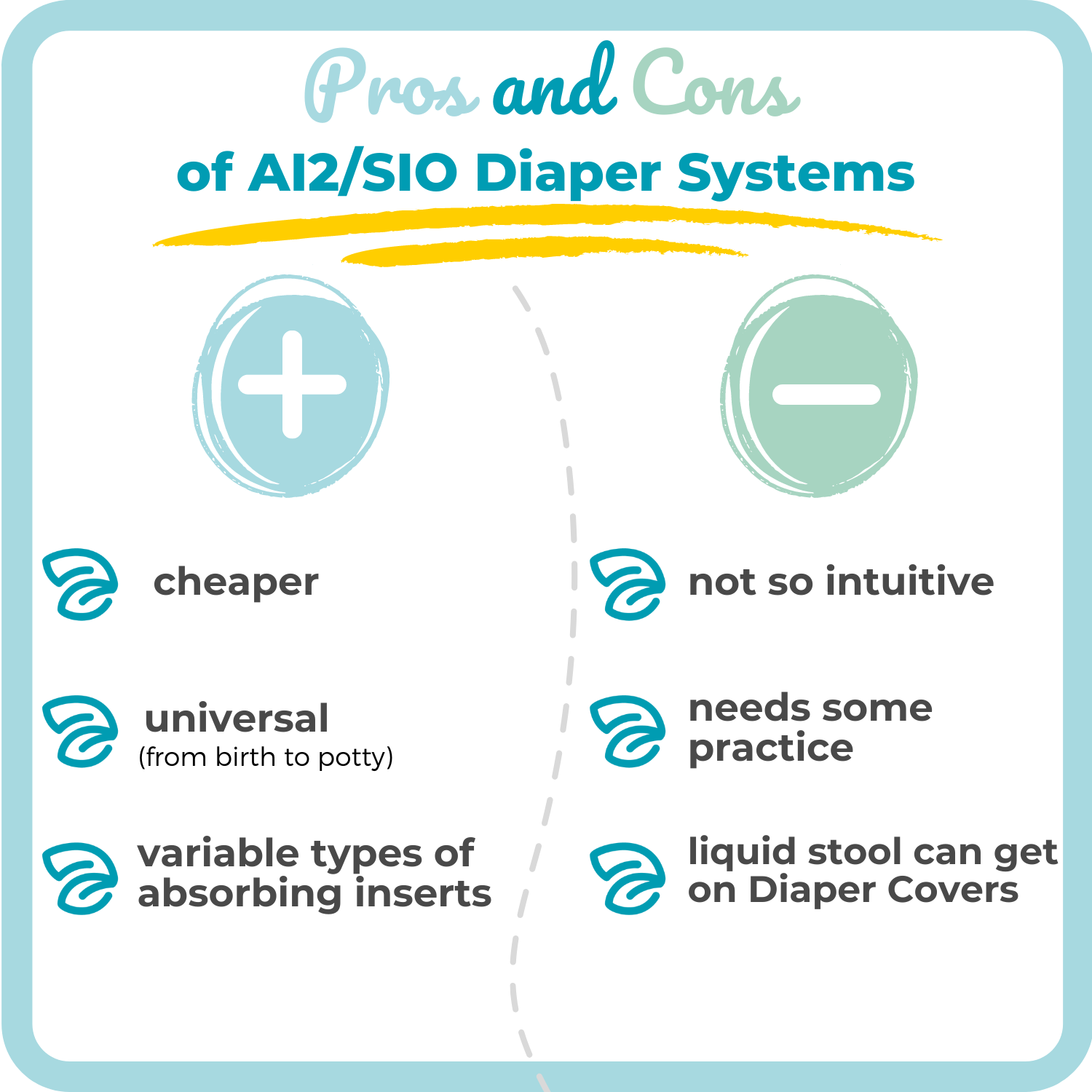
Fitted Diapers
Fitted Diapers are the “best of breed” of AI2 diaper systems. We just mentioned the biggest con of AI2 diapers—using them for newborns can sometimes be tricky. No such problem with Fitted Diapers! They’re the best and most user-friendly diaper option for newborns as they are, well, fitted :-) Elastics around the legs and in the back make sure the diaper fits as a glove and nothing leaks out of it. Moreover, you always have to put a Diaper Cover over, thus creating double protection against leaks.
There are many types of Fitted Diapers and because they’re so practical for newborns, you’ll come across newborn fitted diapers a lot. Same for the night—fitted overnight diapers are the best night diaper change out there, in our opinion. Our Night Fitted Diaper comes with an attached absorbing insert and has a pocket for adding more absorbing inserts. It has a Stay Dry contact layer so that your baby’s bum is dry all night long.
As a fitted diaper for the day, we chose a Fitted Diaper with a practical pocket to put additional absorbing inserts in. We like to pair it with our Long Absorbing Insert from Organic Cotton but it’s up to you what you put inside—even a Muslin Square will work.
The only con of fitted diapers is that you need to put two diapers on your baby. Fitted diapers and then a Diaper Cover over it. Which is fine with newborns as they lie on their back not trying to crawl away. But it can be more tricky when changing a curious active toddler who needs to explore the world around them and a diaper change is certainly not at their list of interests at the moment.
Fitted diapers have a lot of sewing going on when we make them and the fabrics we use need to be of the highest possible quality (they need to withstand a lot of washing cycles and still be usable). That means their price is much higher than the price of regular absorbing inserts. If you choose mostly fitted diapers for your diaper stash, it will be one of the pricier diaper solutions.
AIO: Diapers with both the absorbing and the waterproof layer in one
AIO, AII-in-One Diapers. The “real” AIO Diapers are literally one diaper with all the layers sewn together. The advantage of these is their user-friendliness—you put them on as easily as a disposable diaper, there’s not much difference. Anyone can do it, be it grandma, grandpa, or your babysitter.
However, this advantage has its flip side—after each use, you have to wash the entire AIO diaper. And let it dry. Which can last forever given the fact that an AIO diaper can’t be tumble dried (this may damage the waterproof layer). A really absorbing AIO diaper can take 2 days to dry completely (especially in colder weather or in humid environment).
So, if you want to build your diaper stash mostly with AIO diapers, let’s be straightforward here and say that it’s the most expensive alternative on the market. With the long washing and drying process, you’d need at least 30 AIO diapers to always have enough of clean and dry diapers at hand.
We know from experience that a lot of our customers buy a one or two “real” AIO diapers because they’re so easy to use. Just to try them out or as the most foolproof diaper option. Customers very rarely build the entire diaper stash just with AIO diapers.
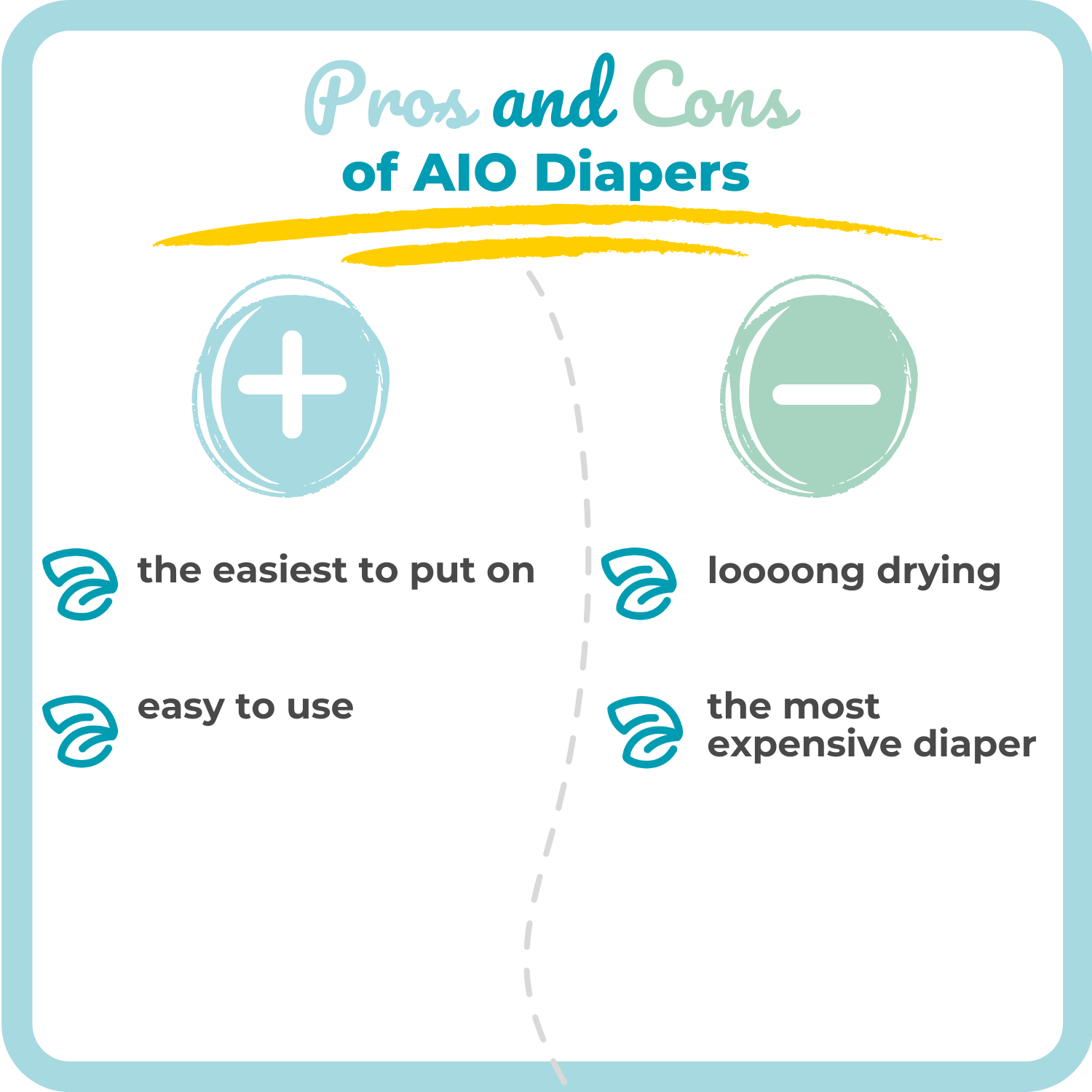
Pocket Diapers
Due to the cons of “real” AIO diapers, they’re not that common at the diaper market. We also don’t have them in our portfolio :-) Similarly as many other diaper manufacturers, we deal with the drying problem by making the absorbing and the waterproof layer detachable. They both need to be washed after each use, but the absorbing part can be tumble dried and the waterproof part (the pocket) doesn’t take that long to dry on its own. Even if you don’t have a tumble dryer, detaching the layers from each other significantly speeds up the drying process (contrary to drying a “real” AIO diaper when the layers are stacked on top of each other).
Our Pocket Diaper has a waterproof pocket with contact (next-to-skin) layer made of bamboo terry. The absorbing layer is represented by Shaped Insert for Pocket Diaper which can be put inside the pocket or on it (depending whether you want to use bamboo terry or Stay Dry as the next-to-skin layer). We think this is a great compromise between an AI2 and an AIO diaper system as inserting and pulling out the absorbing layer in the pocket takes seconds and apart from that, our Pocket Diaper is still as easy to use as a disposable. Any other absorbing insert can be used in the pocket, even a Muslin Square will work.
Our Pocket Diaper has one more feature that we like to mention—as well as our Diaper Covers, it has double hems around the legs. This makes it an absolutely leakproof and very reliable diaper even for babies whose stool is still liquid. It fits babies from just 3,5 kg and will take you through the entire diaper period.
However, the main con of AIO diapers—their price—applies to Pocket Diapers, too. You need at least 20 of them so that you don’t run out of clean diapers (if you plan to wash your cloth diapers every other day).
So this is it, these are all the diaper systems out there. You may find more types, shapes, and sizes of cloth diapers on the market, but in the end, they will all fall under one of these 4 main categories.
If you have any questions regarding cloth diapers, feel free to contact us! We’re here for you on many channels—call our hotline, reach out for us on our social media or use the chatbox here on our website right now!
Where to go next? Check our article on How to build your cloth diaper stash, if you’ve started thinking about this topic. Or perhaps you’re concerned about How to wash cloth diapers? Or visit our Frequently Asked Questions about cloth diapers—it contains all the topics you can think of with regards to cloth diapers.

